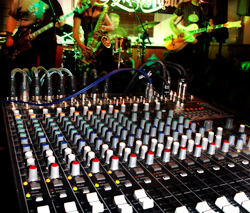Recently, someone at our church sought me out to tell me that every week, our music mix for services sounds fabulous.
As merely the producer of our services, I quickly credited the front of house sound person, and then added, “without the great musicians, it wouldn’t sound good at all.”
Really, when the musicians are great (and just as importantly, playing well together), mixing shouldn’t be too hard. Similarly, if the musicians are substandard, there’s not a whole lot that the sound mixer can do to fix it.
Musicians generally have the same outlook. Several have told me over the years that they really enjoy playing at particular places where the sound is good, and vice versa.
Thus musicians know a sound person can ruin a performance, and a sound person knows that little can be done to improve a bad musical performance. Logic, yes?
There is dependence—in reality both need to be good.
It’s also a fact that good musicians can make a sound person look like the ultimate hero. I learned this early on, when I was a teenager and helping out the local sound company as a “gofer” at a concert featuring the great B.B. King.
He did something that I’ve never seen an artist do again to this date. During sound check, he stopped the band halfway through the first song, turned to the front of house engineer, and stated that he would really appreciate it if the compressor on his microphone were turned off.
He then explained how he likes to work the mic, and knew when to get on the mic and when to back off. In other words, no additional help needed! He knew what he was doing and wanted control to do it.
To his credit, Mr. King did this in a very nice way, even making a joke about how he was so old and had been using mics long before compression was even available, so he was just used to doing it that way.
I spent the night studying how he worked the mic.
One particular thing I noticed is that he would go from having his lips resting on the capsule to backing off almost two feet, using that to help his voice fade in and out of the music (when he wanted that effect).
Since then I’ve talked to several musicians about his approach, and shown them as well (it really needs to be demonstrated). More than one has said it’s helpful.
One final note about great musicians. On occasion, I get to mix big bands, and it’s almost always a joy because the band usually mixes themselves.
Sax soloists, at the right time, lean into the mic and increase their playing volume, while the band eases off just a bit. The same with piano when it’s a solo, and the band backs off even more, without going too quiet.
I love it because it makes me look good, and I can also focus on more subtle things like EQ, effects, and dynamics.
I’ve said it before, but it bears repeating: great live music requires both Tech and Talent (TnT).
Gary Zandstra is a professional AV systems integrator with Parkway Electric and has been involved with sound at churches for more than 30 years.


















